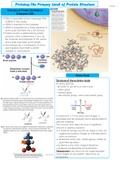Summary
Summary IIA: Molecular Processes- The primary level of Protein Structure
- Institution
- University Of The Witwatersrand (wits)
- Book
- Biochemistry
These are detailed notes that combine the lecture notes and the textbook chapter 5: The primary Structure of Proteins. They include relevant diagrams and pictures to understand the content in a simple way. All components of this chapter are covered and written for ease of studying. This is specific...
[Show more]





